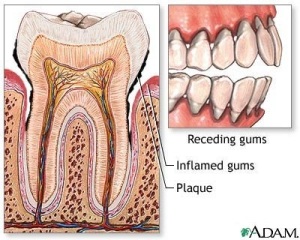By Arthur Kezian
Gum disease is a common ailment affecting many people. The most common type of gum disease is gingivitis that is essentially a term referring to inflammation of the gums. The tissue area around teeth is known as the periodontal area. If this area becomes inflamed or infected, the tissue can be destroyed and ultimately this can lead to tooth loss. Sometimes this is referred to as periodontal disease. Gum damage or loss is a serious condition. Identification, early treatment and, of course, prevention of this ailment is essential for your oral health.
 Dr. Kezian, a Los Angeles dentist, has expertise in identifying gum disease, can provide guidance on treatment options and education on best dental practices to prevent the development of gum disease. Learn more about this common dental condition.
Dr. Kezian, a Los Angeles dentist, has expertise in identifying gum disease, can provide guidance on treatment options and education on best dental practices to prevent the development of gum disease. Learn more about this common dental condition.
What Are The Causes Of Gingivitis?
Plaque, a sticky paste-like goo that consists of bacteria, saliva, and food debris, adheres to the enamel layer of your teeth. This can lead to tooth decay or caries by the production of acid during bacterial fermentation of sugars. As expected, acid erodes the enamel but also irritates and inflames the gum line.
- If plaque is not properly removed, it can become harder, turning into tartar.
- Plaque and tartar, when located as a bump at the base of the tooth or gum line, can irritate the gums, resulting in tenderness and swelling
- Bacteria trapped within the plaque can grow in number and infect the gums leading to more swelling and pain.
- If you have an autoimmune disease, diabetes not properly controlled or poor dental hygiene, you are at a higher risk of developing gingivitis.
- Poor fitting fillings or teeth that are misaligned create more nooks and crannies that can trap plaque, therefore, putting you at higher risk of gum disease.
What Are The Symptoms Of Gingivitis?
- Changes in the color of the gums from a healthy salmon pink to bright red or purple
- Puffiness or swelling of the gum line
- Tenderness to the touch when eating or brushing
- Bleeding, especially noticeable during tooth brushing
- Higher incidence of painful mouth sores
How Does The Dentist Identify Gingivitis?
- During a thorough oral examination, the dentist will look at the color and shape of your gums, noting bright red or purple color or swelling.
- Using a probe, the dentist will check for tenderness or pain, bleeding and gum recession
- The presence of plaque or tartar will be noted.
- Dental X-rays may be taken to evaluate the extent of gum disease and look for the presence of associated tooth caries or cavities.
How Do You Treat Gingivitis?
- Cleaning and removing plaque and tartar is the first step. Care is taken at the base of the tooth and between the teeth, commonly missed areas in a normal dental hygiene routine.
- Dr. Kezian and staff will take the time to instruct and demonstrate for you optimal dental hygiene practices to prevent the recurrence of plaque build-up and reduce the incidence of inflammation
- Antibacterial mouth rinses can reduce the amount of oral bacteria, thereby reducing the incidence of infection
- Repair of poor fittings and fixing misaligned teeth can decrease plaque and tartar collections
Will Gingivitis Come Back?
 Once a professional cleaning removes the cause of irritation and infection, mainly the presence of plaque, the symptoms of gum disease such as tenderness and swelling should go away in one to three weeks.
Once a professional cleaning removes the cause of irritation and infection, mainly the presence of plaque, the symptoms of gum disease such as tenderness and swelling should go away in one to three weeks.- Good dental hygiene practices including proper tooth brushing techniques, flossing after meals and mouthwash will prevent gingivitis from returning by preven
- Treatment of systemic diseases such as diabetes will lower your risk of a recurrence as well.
Gum disease affects many people, resulting in bleeding when tooth brushing and other discomforts. In addition, untreated gingivitis can result in tooth decay or loss. Dr. Kezian, a Los Angeles dentist, can rapidly identify the signs and symptoms of gingivitis during a professional oral examination, will treat the cause of the disease and will provide education on best practices to prevent the recurrence of gum disease.
Dr. Arthur A. Kezian DDS - 443 N. Larchmont Blvd Los Angeles, CA 90004 (323) 467-2777 https://www.drkezian.com
